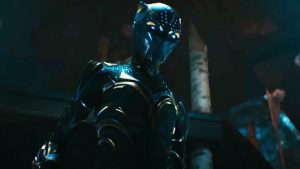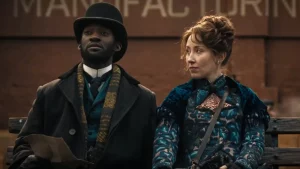
This article contains spoilers for Terminator Zero.
“The future’s not set,” says John Connor in Terminator 2: Judgement Day, quoting his mother Sarah. “There’s no fate but what we make for ourselves.”
That tension between fate and free will has been the driving force of the Terminator franchise, even more so than the killer robots who show up in every installment. That includes the most recent entry, the Netflix anime Terminator Zero.
Zero takes place in two timelines. The first runs parallel to T2 in 1997 Japan, where American expatriate Malcolm Lee (André Holland) is working on an AI called Kokoro (Rosario Dawson) to rival Skynet. The second is in the human/robot war of 2022, where a human resistance led by the Prophet (Ann Dowd) has sent a fighter named Eiko (Sonoya Mizuno) back in time to stop Lee. Unbenownst to her, the machines have also sent back a terminator (Timothy Olyphant) to kill Lee as well.
Yes, that’s a lot. To its credit, Terminator Zero addresses the knot made not just by the show, but by every entry in the Terminator franchise, giving the clearest look yet at how the humans and the machines have changed reality by sending naked people back and forth through time.
Straightening Out the Timeline
“Let’s talk about time travel and paradoxes,” says the Prophet at the start of Terminator Zero‘s sixth episode, directed by Masashi Kudô and written by showrunner Mattson Tomlin. “Most people think of something like this when they picture time,” the Prophet tells Eiko, using a small flame to draw a yellow line in the air. While she allows that most people move along that linear line of time, the Prophet points out that things change when people go back in time. “When you go back in time, you go to a past, not the past,” she explains, putting emphasis on the articles. “The point in time you’re traveling to and the point you’re coming from are different timelines.”
Honestly, that’s not hard to understand for most people watching Terminator Zero. After all, the Prophet’s description and visuals look a lot like those that the Ancient One showed Bruce Banner in Avengers: Endgame. And since Marvel won’t stop making movies about timelines and branching realities, we understand that time travel leads to new realities and alternate universes.
But that’s new information for people within the Terminator universe. The original James Cameron movie from 1984 is based on the idea that time is a more or less closed loop. Sure, the machines send the T-800 back to kill Sarah Connor before she can give birth to resistance leader John. But the human response is to send back Kyle Reese to protect her, and Reese ends up siring John with Sarah.
T2 repeats many of those same beats, this time with a T-1000 sent to kill the now-grown John and a T-800 sent back to protect him, but it ends on a more hopeful note. Furthermore, we learn that Miles Dyson gets the missing piece for Skynet by studying the arm of the first T-800, thus suggesting another loop. But by the end of the movie, it seems that John, Sarah, and the T-800 have stopped Skynet from going online and thus prevented Judgement Day, supporting the lesson about free will that the elder Connor imparted on the younger.
From there, it gets much, much messier. Terminator 3: Rise of the Machines says Judgement Day will still happen, but later in the future now. Terminator Salvation involves the machines trying to kill Kyle Reese before he goes back in time to meet Sarah and make John. Terminator Genisys really upends things with a way too convoluted plot about the T-800 raising Sarah as a child and John Connor becoming a machine and also Matt Smith is there, while Terminator: Dark Fate begins with John’s death as a child and Sarah protecting the next mother of a future leader, with the help of an aged T-800.
None of that even gets into the numerous books, comics, and video games that expand on the lore, nor on the TV series The Sarah Connor Chronicles or the Universal Studios attraction Terminator 2:3D.
A Self-Made Fate
In short, the time travel in Terminator is a mess. Obviously, the problems in these plot lines stem mostly from the fact that Cameron isn’t really involved with any entry past T2. The creators that followed can’t tell stories exciting enough to distract from the nonsense plot mechanics, making their problems stick out more, or they’re so invested in paying homage to what came before that they need to keep finding excuses to replay moments from the first two films.
But whatever the reason, Zero‘s explanation cleans things up nicely by putting all of these movies in their own reality. Now we don’t need to figure out why John Connor was a resistance leader in most of the movies, even though he dies as a kid in Dark Fate and becomes a robot in Genisys. Those are all separate universes, not flowing in a straight line from the first two Cameron movies.
Fittingly enough, Terminator Zero practices what it preaches by limiting the nods to other films. Do we get a metallic thumbs up and a robot foot smashing a human skull? Sure! But most of the series focuses on its own, new convoluted timeline and the mystery of Lee and Kokoro.
Will Terminator Zero‘s timeline and new characters end up just as messy as the stuff from other Terminator entries? Maybe. But that’s Zero‘s problem. It’s a fate that Zero made for itself.
Terminator Zero is now streaming on Netflix.
The post Netflix’s Terminator Zero Explains the Franchise’s Complicated Timeline appeared first on Den of Geek.









